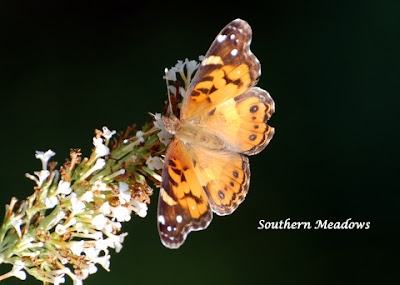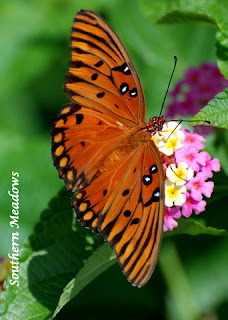The Brushfoots
One of the best represented butterfly families in my garden at this time of year are the Brush-footed butterflies. They are easily identified by their shorter forelegs which are frequently hairy and look like brushes.
This American Lady blends in very nicely amongst the mulch. Had she not moved when I walked by I would have missed her all together.
When she opened her wings to bask in the morning sun the light shone through her wings glowing a beautiful orange .
The ladies are common across all of North America. To attract these try plants in the aster family. The caterpillars eat thistles and cudweeds which are in abundance in the empty lots surrounding my house.
Another group of the Brushfoot family are the Fritillaries. They are large, orange butterflies with brightly silvered or white spots on their underwings.
The Gulf Fritillary lay their eggs on native passion vines and maypops.
I found this Great Spangled Fritillary basking on my shrubbery before it took off to drink nectar at the nearby Buddleia bush. Caterpillars feed on violets of which I have many growing wild in my woodland garden.
The Admirals are another member of the Brushfoots. The one most common in my garden is the Red-spotted Purple.
With its brilliant blue and red spots it is often confused with the Pipevine Swallowtail but doesn't have the tails like the swallowtail. The Red-spotted purple host plants include wild cherry, poplars, and hawthorns.
Unlike most butterflies that feed on nectar, they feed mostly on decaying organic matter, rotting fruit and moisture from damp sand. They often find their food source in my compost bin but another method is to provide over ripe fruit in a suet feeder.
The Crescents are small versions of fritillaries. Their host plant is the aster and are most often seen on milkweeds, black-eyed susans, asters and coreopsis. However, I caught this one on my lantana.
Just an friendly reminder that butterflies are dependent upon plants to provide nourishment for their young and nectar from flowers for their adult food. Many butterflies are dependent upon a few specific plants for their survival and some of these plants are dependent upon unique habitats for their survival. Therefore, habitat conservation is needed. Butterfly gardening is one way to help and enjoy the benefits of seeing these gorgeous creatures up close in your garden.
I am linking up today for Macro Monday. Take a look at all the amazing macros taken by fellow bloggers. Happy Monday y'all!













.png)
